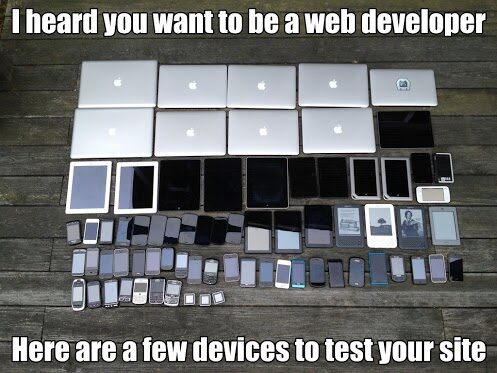Mobile traffic, mobile websites, mobile apps. These and similar phrases are increasingly being discussed in SEO circles, but sometimes (and I am as guilty of this as anyone) we forget to define what we actually mean by the term ‘mobile’.
The Official Definition
The Mobile Marketing Association recently defined ‘mobile marketing’ as “a set of practices that enables organizations to communicate and engage with their audience in an interactive and relevant manner through and with any mobile device or network.” [emphasis mine]
But to the average person (at least here in the UK), ‘mobile’ is a synonym for ‘cell phone’. No one says, ‘let me look it up on my mobile’ and then takes out an iPad. Tablets, smartphones and feature phones are all very different devices, and encourage different behaviours, and therefore require different marketing approaches.

[image credit: http://www.loneshooter.com/wp-content/uploads/2013/04/web-development-test-01.jpg]
The gap is certainly narrowing between tablets and smartphones in terms of size variations, as we increasingly see wider ranges in both types of product. But the ways in which we use tablets are not necessarily the same as the ways we use our smartphones, and a feature phone is a completely different beast. So why are we still lumping them into the same unwieldy category of ‘mobile’?
Some might argue that it’s because tablets and smartphones, while not the same thing at all, are still more similar to each other than they are to a desktop. But tablet visitors often behave more like desktop visitors than like smartphone visitors; if anything, tablets seem increasingly to be used as a quicker alternative to the laptop.
The Problem
Take a look at some of these recent stats:
The Solution
I’ll be honest. I don’t know what the whole solution is. But there are some things for us to think about going forward.
More Specificity
I’d certainly like to see us be more specific in our discussions of ‘mobile’. The language we currently use is too vague. For example, when we talk about ‘mobile marketing’, do we mean a smartphone-accessible website or SMS promotions? When we talk about a ‘mobile strategy’, do we mean adding click-to-call numbers to our site? Or do we actually mean a strategy for a multiscreen consumer journey?
Intent vs Device
One thing which all of the above stats have in common is a focus on user behaviour. So an approach that could be useful is to start thinking in terms of ‘intent’ and ’behaviour’ rather than ‘device’. With this approach, a ‘mobile’ interaction would be one which takes place when the user is not at home or work, but out and about, and a ‘mobile strategy’ would be one which addressed the needs of users for those types of interaction. But we do see certain behaviour patterns which are based on the capabilities of the device, so we can’t completely separate device from intent. And this emphasis on intent is something we should be looking for in all online interactions, not just mobile ones.
Different but not Independent
Each of these devices differs from the others more than we might imagine at first glance. And yet each of them needs to be able to work together with the others seamlessly, because consumers no longer use a single device for everything. In fact, we increasingly use multiple devices throughout the day, sometimes for the same transaction.
As SEOs, we need to stop desperately scrabbling to keep up with every new device and browser and OS out there, because we’ll never catch up. While it is obviously important to remain aware of new developments, our ultimate goal as mobile marketers should be to develop approaches which integrate multiple screens and devices more effectively and make that ‘seamless experience’ possible. We also need to have a more granular approach to the data, especially user behavioural data, and actually work to understand how people use these devices.
If we bring together all of these things, I think we can begin to develop a deeper and more insightful appreciation of our ‘mobile’ audience and what they need from us.
—-
Now it’s your turn!
What do you think about the current use of the term ‘mobile’ in digital marketing circles? Is it useful as a blanket term, or should we try to differentiate more between different devices? And is there a simple solution?
I’d love to hear your thoughts in the comments.



